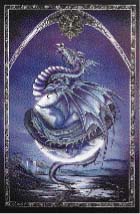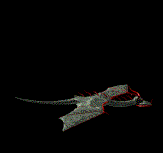The most snakelike of all Dragon species, Amphipteres have no discernable limbs and only two large, graceful wings. Some central and south american species have feathered wings, suggesting that they are more closely related to birds than any of the other saurimmals. The graceful Quetzlcoatl and other central and south-american draconids belong to this family. Some existed in North Africa and the Arabian Peninsula in Classical times, but it is unknown if any remain there today, considering the loss of habitat (frankincense and coffee trees) they have suffered.
 This is an amphiptere; although it has a claw-like appendage on the end of its wing, it lacks limbs besides said wings. (image courtesy of the Dancing Dragon Catalog; note that they mislabel this creature "Earth Dragon".)
This is an amphiptere; although it has a claw-like appendage on the end of its wing, it lacks limbs besides said wings. (image courtesy of the Dancing Dragon Catalog; note that they mislabel this creature "Earth Dragon".)

Here is an amphiptere in action.

Dragon Names Around the World
Here are a few assorted ways in which people the world over say "dragon".
- Ddraig, Draig: Welsh Dragon (my favorite kind!) Note that the word "Draig" is pronounced Drayg, but "Ddraig" is pronounced "HThrayg"; I have never discovered which spelling (and hence, pronunciation) is considered standard in Wales, and I have seen both in reference works.
- Druac: Irish Dragon
- Drakon: Greek Dragon
- Draco: Roman (latin) Dragon
- Draka: Old English Dragon
- Dreki: Old Norse Dragon
- Drachen: German Dragon
- Chac, Kukulkan: Mayan Dragon
- Hurucan: Carribean Dragon
- Riong: Korean dragon
- Tatsu, Ryu: 2 forms of Japanese for dragon--ryu is the more usual
- Fuku riu (ryu): Japanese dragon of good luck
- Lung, Long or Loong: Chinese dragon (depending on the dialect)
- Mo-o-inanae: Hawaiian mother of dragons
- Phrayanak: Thai Dragon (they resemble Amphipteres)
- Bhutan: literally, "Land of the Thunder Dragon"--pretty nifty name for a country, don't you think?

Email me at dracnova@hotmail.com if you would like to learn more about Dragons!

Click Here to return to my main page. Don't forget to say Hi to Aramis before you leave!


this page is sponsored by  Get your own Free Home Page
Get your own Free Home Page








![]()
![]()

 Get your own Free Home Page
Get your own Free Home Page